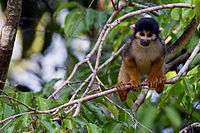Mamirauá Sustainable Development Reserve
| Mamirauá Sustainable Development Reserve | |
|---|---|
|
IUCN category VI (protected area with sustainable use of natural resources) | |
 Map of Brazil | |
| Location | Amazonas, Brazil |
| Nearest city | Tefé |
| Coordinates | 2°16′S 65°41′W / 2.26°S 65.68°WCoordinates: 2°16′S 65°41′W / 2.26°S 65.68°W[1] |
| Area | 4,300 sq mi (11,000 km2)[2] |
| Established | 1996 |
| Designated | 4 October 1993 |
The Mamirauá Sustainable Development Reserve in the Brazilian state of Amazonas, near the city of Tefé, is a 4,300-square-mile (11,000 km2) reserve near the village of Boca do Mamirauá. It includes mostly Amazonian flooded forest and wetlands.
Protection
Mamirauá is recognised by the international Ramsar Convention, as a wetland of global importance, as well as part of a World Heritage Convention's natural site. It has been proposed that the Reserve should form part of a future UNESCO Biosphere Reserve in the Brazilian Amazon. At present, it is included in one of the Ecological Corridors to be implemented by the PPG-7 Program for the Protection of Brazilian Tropical Forests.
The reserve is the legacy and life work of Brazilian scientist José Márcio Ayres.
Mamirauá has a human population estimated in 6,306 individuals, including amazonian caboclo, Ticuna, Cambeba and Cocama ameridian groups.
Wildlife

Mamirauá hosts a large diversity of birds, with more than 400 species recorded, including toucans, harpy eagle, hoatzin, 15 species of parrots and, specially, aquatic birds. Two species of monkeys, the white uakari and the black squirrel monkey are endemic of this region, which is also home of other kinds of arboreal mammals such as howler monkeys, sloths, coati and collared anteaters. Land mammals are not that common as most of the territory is flooded during the wet season. During this season the pink dolphin can be found in the flooded forest.
The most conspicuous of the numerous fish species are tambaqui, piranha and pirarucu. Mamirauá is also a perfect place to spot the Amazon river dolphins, both boto and tucuxi.
References
- ↑ "Mamirauá State Sustainable Development Reserve". protectedplanet.net.
- ↑ "Peering at the future". The Economist. 17 June 2004.
- Koziell, Izabella; Inoue, Christina Y. A. (2002). Mamirauá Sustainable Development Reserve, Brazil. IIED. ISBN 1-84369-241-4.
- Bannerman, Matt; Marigo, Luiz Claudio; Azevêdo, Aline Da Rin P. (2001). Mamirauá: A Guide to the Natural History of the Amazon Flooded Forest. Instituto de Desenvolvimento Sustentável Mamirauá. ISBN 85-88758-02-4. Cite uses deprecated parameter
|coauthors=(help)